I came to the Netherlands in March hoping to see the country by bike, and to learn about its biking culture.
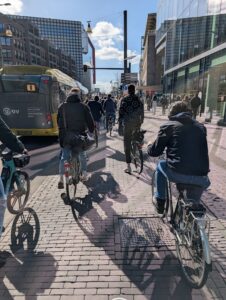 There’s a lot of talk about moving that culture to the U.S..
There’s a lot of talk about moving that culture to the U.S..
That’s not going to happen.
It will be just as difficult to save the biking culture here as export it.
The Dutch bike paths, called fietspaden, are wonderful, but they’re becoming hopelessly polluted by the same demand for speed that’s getting Americans killed in droves. You can ride without a helmet, and you can carry your groceries while you ride, but you can only do it in an urban setting. The good news is that, thanks to a premium given to land use, nearly all Dutch living, even in suburbs, is tightly packed.
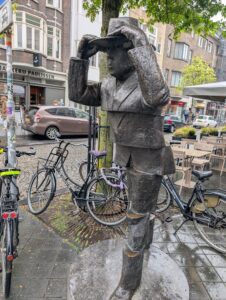 Dutch cycling culture is built around bikes you can’t ride more than 5 miles on without extreme discomfort. You sit up straight. You see the traffic all around you. It takes little effort, and with an electric even less.
Dutch cycling culture is built around bikes you can’t ride more than 5 miles on without extreme discomfort. You sit up straight. You see the traffic all around you. It takes little effort, and with an electric even less.
But by sitting so upright, all your weight rests on your backside. Because you’re upright, the muscles on top of your thighs, the quadriceps, are doing all the work. A Dutch bike is also too slow for American roads, a top speed of 15 mph (25 kph). In practice, on city streets, Dutch cycles roll at 10 mph (16 kph) or less.
Bike paths are thus a must here. The same with the priority that bikes are given over cars. When cars hit bikes here, it’s always the car driver’s fault. Bikes don’t have to follow traffic laws and often don’t.
Go Fast, Go Big
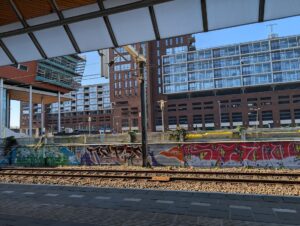
I have spent many hours on the trains over the last month. I love them. Sadly, they’re not very fast, and they’re not very cheap. Most Netherlanders drive to work, and their cars are getting heavier thanks to the e-transport revolution. Government faces a choice between maintaining roads for the upper middle class or supporting biking infrastructure for what’s increasingly the lower middle class. Guess whose side they’re taking?
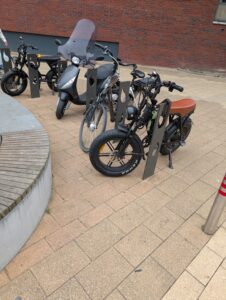
Then there are the motorcycles – loud, gas-powered, smelly, and even faster than the fat bikes. Once you’re out of any central city these two vehicles dominate fietspaden.
Go out of town for the weekend, to the Hoge Voluwe and it’s louder than Amsterdam. There are so many Harleys on the road it could be the Blue Ridge Parkway. It ruins the mood, even when the hogs are stopped for ice cream.
I rode 30 miles around the park the other day, on a Dutch bike, and I have yet to recover. I looked stupid, I felt worse, and the result was unsatisfactory.
Second Class Life for Tourists
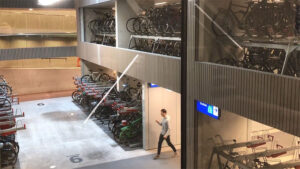
I missed a lot of what makes the Dutch system great, secure garages with repairmen inside, and quick rentals at train stations.
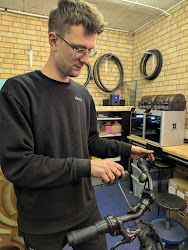
A big selling point of Dutch cycling is the piles of bikes in front of shops, restaurants, and stores, allowing for smaller car parking lots. Those piles of bikes are real. They’re cheap, they’re small, you can get right up next to where you’re going. Security may be a ring lock around the back tire, even on an electric. It’s great. You can stop anywhere, for a meal, a drink, and give no thought to your ride home.
For how long?
Space, The Final Frontier

There are layers and layers to Dutch transportation. Inside a city, like Utrecht or Amsterdam, most people get around using Dutch cycling. Go to the edge of even these cities, and things change quickly. You see more fat-tire bikes, more motorcycles, ridden by people who seldom go to the city center because there’s no room for them.
Then there are the cars. They come into these edge cities, then go out again. They never go beyond the edge. Parking costs too much.
This is becoming a political divide. There’s still a consensus favoring the concept of the fietspaden and bicycling, but it’s just a general one. When choices must be made between subsidizing trains or fixing roads, drivers vote for roads. Since drivers have money, the railroads suffer, and so do policies around the fietspaden. The drivers’ kids are on fat tires and, when they are old enough, on loud motorcycles. Maybe the cycles go electric in the next five years, but they’re still going to be fast, and a hazard to Dutch cycling.
A bicycling paradise doesn’t exist.










